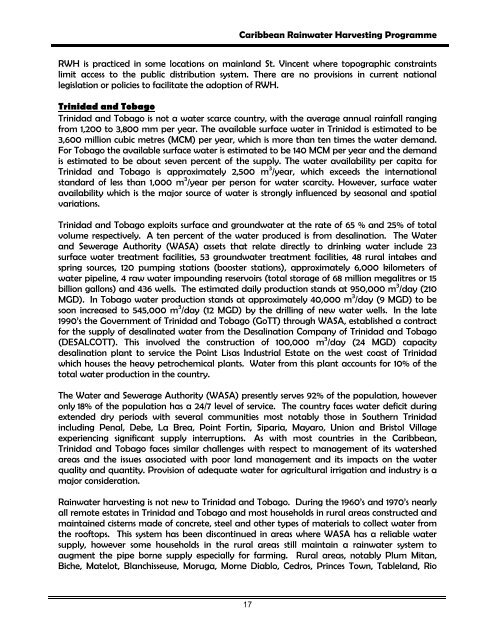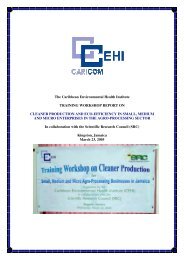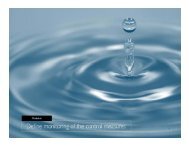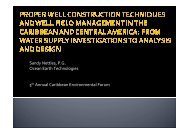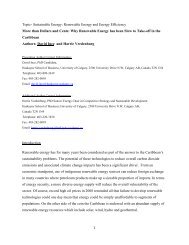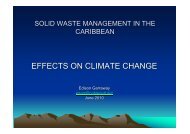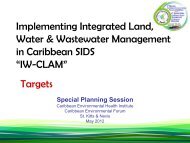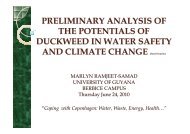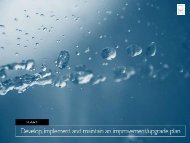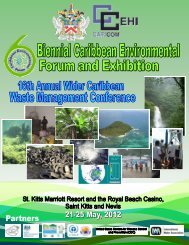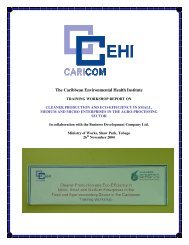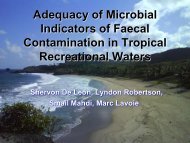A programme for Promoting Rainwater Harvesting in the Caribbean
A programme for Promoting Rainwater Harvesting in the Caribbean
A programme for Promoting Rainwater Harvesting in the Caribbean
Create successful ePaper yourself
Turn your PDF publications into a flip-book with our unique Google optimized e-Paper software.
<strong>Caribbean</strong> <strong>Ra<strong>in</strong>water</strong> <strong>Harvest<strong>in</strong>g</strong> ProgrammeRWH is practiced <strong>in</strong> some locations on ma<strong>in</strong>land St. V<strong>in</strong>cent where topographic constra<strong>in</strong>tslimit access to <strong>the</strong> public distribution system. There are no provisions <strong>in</strong> current nationallegislation or policies to facilitate <strong>the</strong> adoption of RWH.Tr<strong>in</strong>idad and TobagoTr<strong>in</strong>idad and Tobago is not a water scarce country, with <strong>the</strong> average annual ra<strong>in</strong>fall rang<strong>in</strong>gfrom 1,200 to 3,800 mm per year. The available surface water <strong>in</strong> Tr<strong>in</strong>idad is estimated to be3,600 million cubic metres (MCM) per year, which is more than ten times <strong>the</strong> water demand.For Tobago <strong>the</strong> available surface water is estimated to be 140 MCM per year and <strong>the</strong> demandis estimated to be about seven percent of <strong>the</strong> supply. The water availability per capita <strong>for</strong>Tr<strong>in</strong>idad and Tobago is approximately 2,500 m 3 /year, which exceeds <strong>the</strong> <strong>in</strong>ternationalstandard of less than 1,000 m 3 /year per person <strong>for</strong> water scarcity. However, surface wateravailability which is <strong>the</strong> major source of water is strongly <strong>in</strong>fluenced by seasonal and spatialvariations.Tr<strong>in</strong>idad and Tobago exploits surface and groundwater at <strong>the</strong> rate of 65 % and 25% of totalvolume respectively. A ten percent of <strong>the</strong> water produced is from desal<strong>in</strong>ation. The Waterand Sewerage Authority (WASA) assets that relate directly to dr<strong>in</strong>k<strong>in</strong>g water <strong>in</strong>clude 23surface water treatment facilities, 53 groundwater treatment facilities, 48 rural <strong>in</strong>takes andspr<strong>in</strong>g sources, 120 pump<strong>in</strong>g stations (booster stations), approximately 6,000 kilometers ofwater pipel<strong>in</strong>e, 4 raw water impound<strong>in</strong>g reservoirs (total storage of 68 million megalitres or 15billion gallons) and 436 wells. The estimated daily production stands at 950,000 m 3 /day (210MGD). In Tobago water production stands at approximately 40,000 m 3 /day (9 MGD) to besoon <strong>in</strong>creased to 545,000 m 3 /day (12 MGD) by <strong>the</strong> drill<strong>in</strong>g of new water wells. In <strong>the</strong> late1990’s <strong>the</strong> Government of Tr<strong>in</strong>idad and Tobago (GoTT) through WASA, established a contract<strong>for</strong> <strong>the</strong> supply of desal<strong>in</strong>ated water from <strong>the</strong> Desal<strong>in</strong>ation Company of Tr<strong>in</strong>idad and Tobago(DESALCOTT). This <strong>in</strong>volved <strong>the</strong> construction of 100,000 m 3 /day (24 MGD) capacitydesal<strong>in</strong>ation plant to service <strong>the</strong> Po<strong>in</strong>t Lisas Industrial Estate on <strong>the</strong> west coast of Tr<strong>in</strong>idadwhich houses <strong>the</strong> heavy petrochemical plants. Water from this plant accounts <strong>for</strong> 10% of <strong>the</strong>total water production <strong>in</strong> <strong>the</strong> country.The Water and Sewerage Authority (WASA) presently serves 92% of <strong>the</strong> population, howeveronly 18% of <strong>the</strong> population has a 24/7 level of service. The country faces water deficit dur<strong>in</strong>gextended dry periods with several communities most notably those <strong>in</strong> Sou<strong>the</strong>rn Tr<strong>in</strong>idad<strong>in</strong>clud<strong>in</strong>g Penal, Debe, La Brea, Po<strong>in</strong>t Fort<strong>in</strong>, Siparia, Mayaro, Union and Bristol Villageexperienc<strong>in</strong>g significant supply <strong>in</strong>terruptions. As with most countries <strong>in</strong> <strong>the</strong> <strong>Caribbean</strong>,Tr<strong>in</strong>idad and Tobago faces similar challenges with respect to management of its watershedareas and <strong>the</strong> issues associated with poor land management and its impacts on <strong>the</strong> waterquality and quantity. Provision of adequate water <strong>for</strong> agricultural irrigation and <strong>in</strong>dustry is amajor consideration.<strong>Ra<strong>in</strong>water</strong> harvest<strong>in</strong>g is not new to Tr<strong>in</strong>idad and Tobago. Dur<strong>in</strong>g <strong>the</strong> 1960’s and 1970’s nearlyall remote estates <strong>in</strong> Tr<strong>in</strong>idad and Tobago and most households <strong>in</strong> rural areas constructed andma<strong>in</strong>ta<strong>in</strong>ed cisterns made of concrete, steel and o<strong>the</strong>r types of materials to collect water from<strong>the</strong> rooftops. This system has been discont<strong>in</strong>ued <strong>in</strong> areas where WASA has a reliable watersupply, however some households <strong>in</strong> <strong>the</strong> rural areas still ma<strong>in</strong>ta<strong>in</strong> a ra<strong>in</strong>water system toaugment <strong>the</strong> pipe borne supply especially <strong>for</strong> farm<strong>in</strong>g. Rural areas, notably Plum Mitan,Biche, Matelot, Blanchisseuse, Moruga, Morne Diablo, Cedros, Pr<strong>in</strong>ces Town, Tableland, Rio17


